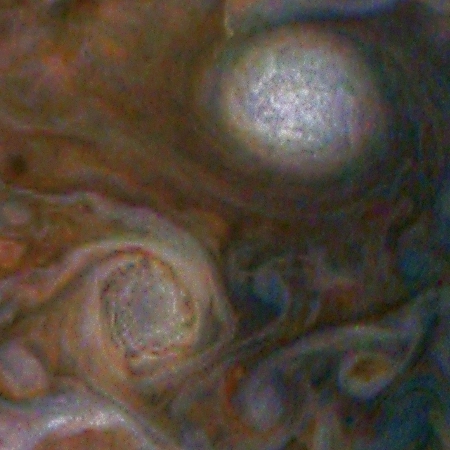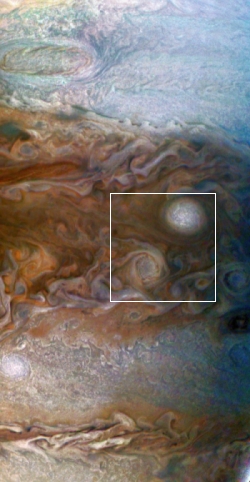The storms of Jupiter

Cool image time! The image on the right, taken by Juno during its fifth close fly-by of Jupiter in late March and cropped to post here, shows two of the major storms in what I think is one of Jupiter’s main large mid-latitude belts. The full image, posted below in a significantly reduced form but annotated by me to indicate the location of the inset, covers a much larger area, but I have specifically zoomed into these two storms to highlight how large these storms are as well as how much detail is hidden within them.
In the bright spot in particular (officially called A6 by planetary scientists) you can see a hint of the existence of innumerable mini-storms. Juno’s camera does not have the resolution to image these smaller storms, but this image suggests that the gas giant’s atmosphere is far far far more complex than we can yet imagine.

Unfortunately, these images do not provide a scale. Based on a global image taken by Juno in October 2016 and matching the gas giant’s major horizontal bands, the annotated full image strip on the left appears to cover a little less than a third of Jupiter, from about 10 degrees latitude to about 50 degrees latitude. From this I estimate that if we put the Earth in the inset image it would probably be only slightly larger than the image itself, which means these two storms would cover most of one hemisphere.
In other words, the mini-storms inside the big bright oval are still larger than the biggest hurricanes on Earth, and they are packed together inside a much larger planet-sized storm.
What should fill us with even more awe is that this only covers a very thin slice of the top of Jupiter’s deep atmosphere. The planet itself is about 89,000 miles in diameter, more than ten times larger than Earth. The depth of its atmosphere is not really known, but it must be deeper than several Earths, piled on top of each other. In that depth there must be many atmospheric layers, each thicker and denser than the one above, and each with its own weather systems and complexities.
It will take centuries of research, including the development of new engineering capable of accessing this place, to even begin to map out its meteorology. And this is only one gas giant, of what we now know must be millions and millions throughout the galaxy.
If we have the nerve and daring, the human race has the opportunity to go out there and never be bored. There will always be something unknown to discover.
On Christmas Eve 1968 three Americans became the first humans to visit another world. What they did to celebrate was unexpected and profound, and will be remembered throughout all human history. Genesis: the Story of Apollo 8, Robert Zimmerman's classic history of humanity's first journey to another world, tells that story, and it is now available as both an ebook and an audiobook, both with a foreword by Valerie Anders and a new introduction by Robert Zimmerman.
The print edition can be purchased at Amazon or from any other book seller. If you want an autographed copy the price is $60 for the hardback and $45 for the paperback, plus $8 shipping for each. Go here for purchasing details. The ebook is available everywhere for $5.99 (before discount) at amazon, or direct from my ebook publisher, ebookit. If you buy it from ebookit you don't support the big tech companies and the author gets a bigger cut much sooner.
The audiobook is also available at all these vendors, and is also free with a 30-day trial membership to Audible.
"Not simply about one mission, [Genesis] is also the history of America's quest for the moon... Zimmerman has done a masterful job of tying disparate events together into a solid account of one of America's greatest human triumphs."--San Antonio Express-News


Viewed from afar this way, this strikes me as a perfect visual example of the unpredictability of weather. Pure chaos.
Chaos indeed, and yet I see order to the chaos… Different bands holding storms moving in different directions and yet spin in the same direction, and the difference in color is fascinating all by itself. This would indicate a different substance.
I think the extremely strong magnetic field is what drives electrified/hi pH storms the way they move, but it does it also cause separation of substance?
On earth, warm water in the gulf of Mexico can make a hurricane much stronger with more energy.
One can only imagine the storms generated by temperatures under the Jupiter atmosphere of 50,000 to 60,000°… This is 5 to 6 times hotter than the photosphere of the sun. (surface)
The rising hot gases will drives storms close to the speed of sound.
The center of a hurricane has low barometric pressure which sucks seawater up like a straw. (storm surge) The giant red spot would have the same affect pulling the lower atmosphere up causing it’s red color.
I agree with Robert, Space expiration will never be boring, and centuries of development to be able to explore the depths of our own solar system. someday we will sample this atmosphere and discover new exotic chemicals created from the depths of Jupiter. There may even be a large market for these exotic materials that could only be created in large amounts in this place. A cloud city or a large ship that floats on the dense red spot ocean as it refines rare elements for the future space age…